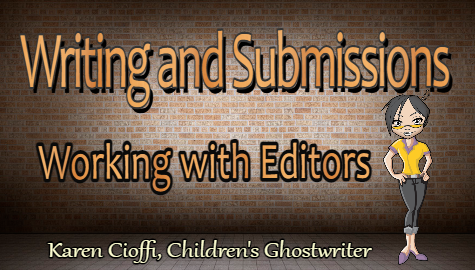Contributed by Anne Duguid Knol
The wonderful thing is that you can annoy an editor at any and all points throughout the publishing process. This allows you to get your own back for all the odd comments sprinkled on every page of your great works from kindergarten onwards. After all, your inbox is full of emails insisting you can make a fortune with your writing in a weekend. Who needs an editor anyway?
Well, if you want to be traditionally published, an editor comes with the package deal. So let’s get off on the most annoying foot from the start.
Submissions
1) Resist reading the publishers’ instructions for sending in submissions. Send in a hefty paper manuscript with all pages stapled together when the instructions ask for email only.
Choose a jolly font — something unusual like Bauhaus 93 or all caps like Algerian. Ignore the boring fonts like Times New Roman which are so often requested by publishers. Word will happily suggest something it considers better if you run out of ideas.
You’ll get more words on the page if you use single spacing and keep the font tiny –try 8 pt.
And better not reread your manuscript before sending it off. After all, you want your editor to have lots to do.
Remember the Rules
2) Follow every typewriting rule you can remember. Sadly we no longer need two spaces before every new sentence. With computers, one space throughout is all that’s necessary. Your editor can sort that one out fairly easily but hitting the space bar to create paragraph indents or using tabs does mean tedious days of extra formatting.
Life is hard enough with the latest version of Word happily saving every copy of your work in a single file and creating huge files which need to be reduced to manageable size.
3) Ignore all rules regarding point of view. After all if you know who’s speaking what’s the problem?
The problem is that readers like identifying with a particular character or characters in a story. This is difficult if they can’t have an in depth involvement. If characters are batting thoughts and feelings about like ping pong balls, it may be exhilarating but it is more likely to lead to confusion than empathy.
However, it’s your book.
Find the right agent
4} Choose an agent who supports your beliefs and ignores requests for blurbs and synopses, sends in an unread manuscript on parenting to a house specializing in Romantic Fiction. Yes, we can see there is a connection there somewhere but publishers and their editors are apt to concentrate on fact or fiction, or at least have different imprints for each.
What’s an Editor For, Anyway?
5} And the final definite No-no. Your editor is not there to write your book. Your editor is there to help you polish your book, make it shine. If you have problems with spelling and grammar, at least do your best to check the manuscript through with Word’s tools if nothing else. Read your manuscript out loud–that’s a good way to find missing words.
Anne Duguid Knol is a local and national journalist in the U.K., Anne Knol is now a fiction editor for award-winning American and Canadian publishers. As a new author, she shares writing tips and insights at Author Support : http://www.authorsupport.net.
Originally published at:
http://www.writersonthemove.com/2016/10/five-ways-to-annoy-editor.html
 The Writing Elements Mix – Is There a Right Balance?
The Writing Elements Mix – Is There a Right Balance?
Striving to Be a Better Writer by Writing More
Book Marketing – You’ve Gotta Have a Blog
 Let me take a look at it. I’m a working children’s ghostwriter, rewriter, and editor. I can turn you story into a publishable and saleable book.
Let me take a look at it. I’m a working children’s ghostwriter, rewriter, and editor. I can turn you story into a publishable and saleable book.
Shoot me an email at: kcioffiventrice@gmail.com (please put Children’s Writing Help in the Subject line). Or, you can give me a call at 834—347—6700
